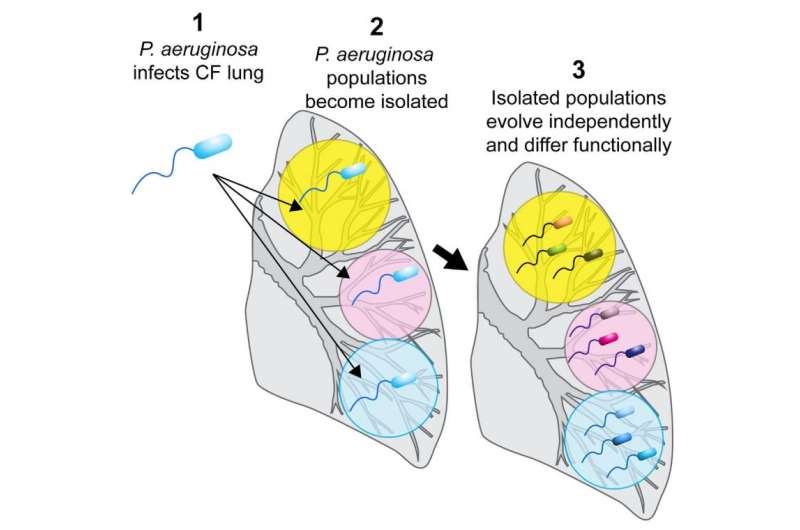Bacteria evolve differences within the lungs of patients with cystic fibrosis

Treatments for the same opportunistic bacteria found in cystic fibrosis patients can work in one area in the lung and be less effective in others. The reason, reported August 20 in Cell Host & Microbe, is that bacteria become isolated from one another and evolve region-specific traits. Researchers saw differences in bacterial nutritional requirements, host defenses, and antibiotic resistance. The findings suggest that other chronic infections may yield similar bacterial diversity.
To understand how chronic bacterial infections persist in the face of antibiotics and immune defenses, researchers from the University of Washington School of Medicine dissected human lungs removed from patients with cystic fibrosis at the time of lung transplantation and collected thousands of one type of bacteria, pseudomonas, from different lung regions. The team found that while all of the pseudomonas in a lung were descendants of a single strain, each region contained a vast array of sibling bacteria that functioned differently.
"What made this so important to us is that the bacterial populations inhabiting different lung regions varied dramatically in terms of their antibiotic resistance and virulence," says lead author Dr. Peter Jorth. "This diversity could affect the patients' health."
When the investigators analyzed the genetic codes of the bacteria, the DNA sequences revealed that diversity arose because bacterial cells had become isolated in different lung regions and then evolved locally, much like Darwin's famed finches in the Galapagos.
The DNA sequences also suggest that traits that evolved over years or even decades may persist in bacteria inhabiting different lung regions and may provide a type of "memory" of past conditions and treatments that strengthen the bacteria.
"Even when a single strain of bacteria causes a chronic infection, evolution with human organs can produce diverse families of related bacteria," says senior author Dr. Pradeep Singh. "This may be part of what makes treatment so difficult, because when bacteria sensitive to one kind of stress are killed, functionally different siblings are there to take their place."
The researchers' next challenge is to use their understanding of how bacteria change during infection to find new ways to attack the diverse mixtures of bacteria that are present and to improve treatment for patients.
More information: Cell Host & Microbe, Jorth et al.: "Regional Isolation Drives Bacterial Diversification within Cystic Fibrosis Lungs" dx.doi.org/10.1016/j.chom.2015.07.006




















